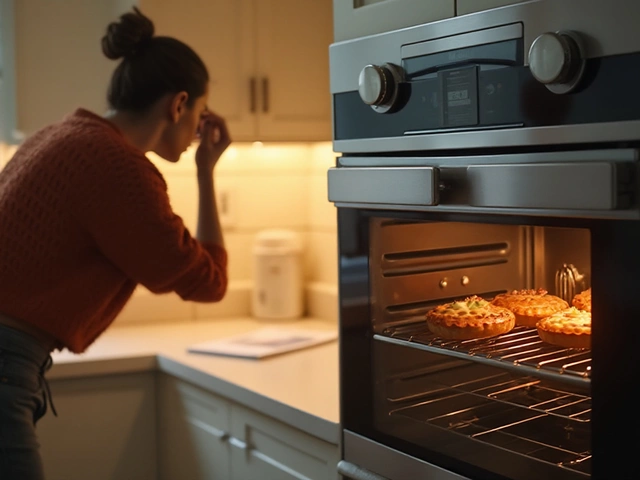Staring at your electric stove, wondering if that repair bill is going to make you regret inviting guests for dinner? You're not alone. It’s tough to juggle rising costs, inconvenient breakdowns, and that nagging feeling you might be wasting money on an old appliance.
Repairing an electric stove isn’t just about swapping out a part—it’s about asking how old the oven is, what’s actually broken, and whether you can do the fix yourself. The price jump between a burnt-out heating element and a fried control board is no joke. Sometimes, quick DIY fixes save the day. Other times, you realize the repair is almost as much (or more) than just heading to the store for a new one.
Here’s a wild stat: Most electric stoves last around 13 years, but some folks still try to patch up a 20-year-old dinosaur. Smart? Maybe not. But if your stove just needs a new burner or switch, repairs are cheap and usually worth it. If you need a totally new panel or multiple big fixes, it's probably time to let go.
- How Much Do Electric Stove Repairs Really Cost?
- Common Electric Oven Problems: Fix or Ditch?
- DIY or Call the Pros? When to Get Help
- Signs Your Stove Isn't Worth Saving
- Tips for Extending Your Electric Oven’s Life
How Much Do Electric Stove Repairs Really Cost?
Let’s talk real numbers. When it comes to electric stove repair, the cost can go from barely noticeable to, “Wait, what?” real quick. On the cheap end, a simple replacement part like a surface burner might set you back just $20–$40, especially if you swap it out yourself. But if we're talking about the control board or wiring, you could be looking at $150–$400 just for the part, not including labor.
Most appliance repair pros charge by the hour. Expect paperwork showing anywhere from $80 to $120 per hour for labor in 2025. And for in-home repairs, they might tack on a flat diagnostic fee—usually between $60 and $100. Sometimes, the diagnostic fee rolls into your total if you go forward with the repair. Don't forget to ask before they show up.
Here’s a closer look at common electric stove repair costs in 2025:
| Repair Type | Part Cost | Labor Cost | Total Range |
|---|---|---|---|
| Burner Replacement | $20–$60 | $80–$100 | $100–$160 |
| Oven Element | $30–$70 | $90–$120 | $120–$190 |
| Thermostat | $40–$100 | $80–$150 | $120–$250 |
| Control Board | $150–$400 | $120–$200 | $270–$600 |
| Door Repair | $50–$150 | $80–$120 | $130–$270 |
If your electric oven is still under warranty, you might get away with paying a whole lot less—or nothing except a service fee.
Here’s a pro tip: If repair costs add up to more than half the price of a new appliance, it’s usually smarter to buy new. For a mid-range electric stove, you’re looking at $500–$900 brand new. Some high-end models will set you back more than $2,000, but you usually don’t need to spend that kind of cash unless you’re running a restaurant out of your kitchen!
Add it up before you commit to a repair. Not every fix is a smart move for your wallet or for your nerves.
Common Electric Oven Problems: Fix or Ditch?
When something goes wrong with your electric stove, you want answers fast. Some issues are routine and cheap to repair, while others signal it’s time to let your *electric oven* retire. Here’s a breakdown of the most common problems and whether they’re usually worth fixing.
- Heating Element Burnout: This is the classic problem—your oven turns on, but no heat. Replacing a heating element is usually an easy, affordable fix (often under $100, even with a tech visit), so unless your oven is ancient, go for it.
- Broken Oven Sensor: If your oven is baking cookies at weird temperatures or food’s always undercooked, the temperature sensor might be off. These can be swapped out pretty quickly and rarely cost more than $50–$125 to fix.
- Faulty Oven Door: If the door won’t shut tight, heat escapes and energy bills climb. New hinges or door gaskets can fix this for less than $60 in parts. It’s a problem worth repairing.
- Blown Fuses or Tripped Breaker: If your whole stove’s dead, check your house’s fuse box first. This is usually an easy DIY fix, unless there’s a deeper issue with the oven’s wiring (which a pro should handle).
- Control Board Failure: When your controls go haywire, the repair gets pricey. A new control board can run $200–$600 with parts and labor. In fact, if your stove is more than 10 years old and the control board is toast, consider replacement.
| Problem | DIY Possible? | Average Repair Cost | Worth Fixing? |
|---|---|---|---|
| Heating Element | Yes | $75–$150 | Usually |
| Oven Sensor | Yes | $50–$125 | Yes |
| Control Board | No | $200–$600 | Only if new |
| Door Hinges/Gasket | Yes | $40–$100 | Yes |
| Wiring Issues | No | $150–$400+ | Depends on age |
Here’s a tip: if a repair costs half the price of a new electric oven or more, think twice before fixing. Also, if your oven’s old enough to legally buy a drink, replacement is usually the smarter (and safer) long-term call.

DIY or Call the Pros? When to Get Help
Not every electric stove repair is rocket science, but some jobs can get dangerous or end up costing more if you mess up. It helps to know which fixes you can handle and when you should call in a professional.
Simple stuff like replacing a broken burner, fixing a loose knob, or swapping out a blown fuse? Most people can tackle these with basic tools and a little patience. For example, if one burner won't heat up, you can usually pop it out, grab a matching part at a hardware store, and snap it back in. Just remember to unplug the stove first—electric shocks are no joke.
- DIY-Friendly Repairs:
- Replacing or tightening loose knobs
- Swapping out single surface burners
- Changing a blown oven light or fuse
- Resetting a tripped breaker
Where it gets risky is with anything electrical inside the oven, especially control boards or wiring. If your oven isn’t heating at all, keeps tripping the breaker, or shows error codes you can’t decode, it’s probably time for a licensed tech. Same goes if you smell anything burning (that’s not food), spot sparking, or the stove is way too old to find parts easily.
- Call the Pros For:
- Faulty wiring, smoking, or burning smells
- Issues with electronic control boards
- Repeated fuse/breaker trips
- Problems under warranty (to avoid voiding it)
Check this out: According to Consumer Reports, the average cost to hire a pro for appliance repair is around $150–$300. Meanwhile, a quick DIY job—like switching a burner—might cost you $30 and half an hour tops. If the repair bill starts creeping past half the price of a new stove, it's probably not worth it to fix unless your oven is pretty new or high-end.
When in doubt, no shame in calling the experts. Better a small service fee now than an electrical fire later.
Signs Your Stove Isn't Worth Saving
Repairing a electric stove is sometimes just tossing money into a bottomless pit. A few problems stand out as big red flags—the kind that say it’s time to stop fixing and start shopping.
- Age Over 13-15 Years: Most electric ovens are built to last around 13 years. If yours is pushing past that, even minor repairs won’t buy much more time.
- Multiple Major Breakdowns: If the appliance repair technician is on a first-name basis with your kids, that’s a bad sign. When different things break one after another, replacement is smarter than sinking cash into what’s almost a new oven already.
- Replacement Parts Hard to Find: Got a rare brand or really old model? If you’re hunting eBay for discontinued pieces, fixing isn’t worth it.
- Smoke, Sparks, or Electrical Smells: Anything electrical that smells burnt, sparks, or crackles? That’s a safety risk, not just an annoyance. Stop using it and get a new stove. Fixing it can be as pricey as a whole new model, and way more dangerous.
- Hefty Repair Costs: A good rule of thumb—if any repair costs are over half the price of a new stove, it’s time to say goodbye. That money is better spent getting a reliable, energy-efficient upgrade.
Here’s a quick comparison to put it in perspective:
| Situation | Repair Cost Estimate | Typical New Stove Price |
|---|---|---|
| Heating element replacement | $80 - $250 | $500 - $1200 |
| New control board | $250 - $400 | |
| Multiple repairs in a year | $400+ |
If you’re looking at more than one $250+ bill within a year, you’re probably better off replacing the oven. It’s also worth remembering that older stoves are less efficient, so high energy bills can sneak up, too.

Tips for Extending Your Electric Oven’s Life
If you want to hold off buying a new stove, some small habits make a huge difference. The way you use and take care of your electric oven decides how many years you’ll actually get from it. A little regular care goes a long way.
- Keep It Clean: Wipe up spills as soon as things cool down. Crumbs and drips baked onto heating elements can block heat and even start smoke or fires. Clean out the drawer underneath too—nobody wants burnt toast crumbs messing up dinner.
- Check Your Seals: The rubber gasket around the oven door is a big deal. If it’s cracked or falling off, heat escapes. That means longer cooking times and wasted energy. Replacing the gasket is cheap and simple for most brands.
- Use the Right Cookware: Flat-bottomed and properly sized pans help the electric stove work more efficiently. Warped pans can make burners overwork, and you’ll use more power for the same recipe.
- Don’t Overload: Too many trays or really heavy items can mess with how heat moves around. Stick to the manufacturer’s suggestions for max loads.
- Be Gentle with Knobs and Controls: Slamming or yanking them off can break the connection inside, leading to expensive repairs. Turn switches with a steady hand to avoid accidental damage.
One study found that ovens with regular maintenance lasted up to 30% longer than neglected ones. Quick checks a couple times a year are worth it. Here’s a simple schedule you can follow:
| Task | How Often |
|---|---|
| Wipe down surfaces and burners | Weekly |
| Inspect and clean oven door seal | Every 3 months |
| Deep clean the interior | Every 6 months |
| Check and tighten knobs/screws | Every 6 months |
| Look for signs of rust or wear | Yearly |
Pay attention to small weird noises, flickering displays, or anything that smells off. Fixing issues early can mean the difference between an easy repair and an expensive disaster. The bottom line: stay on top of cleaning and basic maintenance, and your electric oven and electric stove will easily outlast the average appliance.




